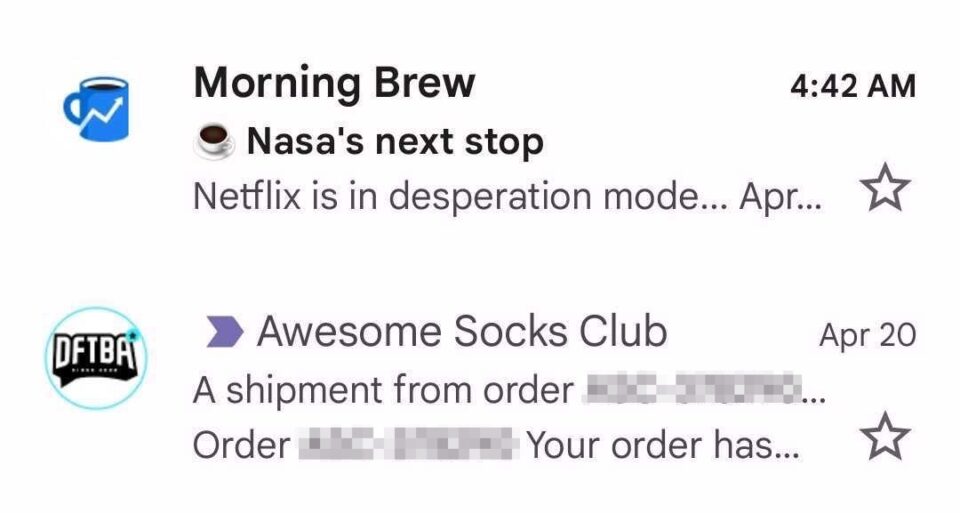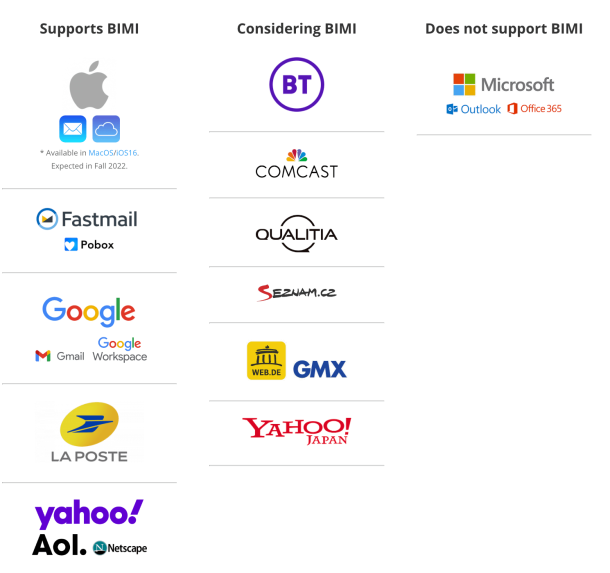BIMI (Brand Indicators for Message Identification) is a relatively new standard for increasing inbox security. Used with DKIM, SPF, and DMARC, it provided you (and your recipients) with top-notch protection and reliability.
With phishing, spoofing, and fraudulent emails on the rise, recipients are increasingly suspicious of messages in their inboxes. They have good reason to be: 60% of Americans claim they or a family member have been scam victims. That’s enough to make just about anyone paranoid.
To add another layer of email protection (and to build brand visibility), email senders can jump on a new standard known as BIMI. Supported by Google, Yahoo!, Fastmail, Mailchimp, Proofpoint, Twilio SendGrid, Validity, and Valimail, BIMI promises to take consumer confidence to the next level. And that’s better for everyone, right?
BIMI stands for Brand Indicators for Message Identification. Developed by the Authindicators Working Group, it’s a standard that attaches your brand’s logo to your authenticated email messages. With this simple, visual verification, recipients can recognize and trust the messages you send.
 But if you already have SPF, DMARC, and DKIM, why do you need BIMI? Good question. Let’s take a high-level look at each to pinpoint the key nuances:
Looking at this list of verification methods, BIMI is the only visual clue a recipient can use to identify a message’s source and authenticity.
But if you already have SPF, DMARC, and DKIM, why do you need BIMI? Good question. Let’s take a high-level look at each to pinpoint the key nuances:
Looking at this list of verification methods, BIMI is the only visual clue a recipient can use to identify a message’s source and authenticity.
 BIMI can help recipients recognize and trust your brand in the inbox. This trust leads to fewer unsubscribes and spam complaints, which can play a big part in boosting your deliverability.
On top of that, you get another layer of protection against phishers and spoofers trying to impersonate your brand. Without the standard accompanying logo, recipients will be wary of messages claiming to be you. And as more businesses adopt BIMI, spam and phishing (in general) will be even more apparent because these messages will lack credible, recognizable logos.
Lastly, BIMI allows you to market your brand even if the recipient doesn’t open your email. That’s right. Sometimes recipients are busy, and your subject line might not be compelling enough to click on at the moment—regardless, your recipients will connect your sender address, subject line, and preheader text with your logo, helping further build your brand.
BIMI is a text record that lives on your sending servers—in your Domain Name System (DNS) records. Agari, one of the email security companies that make up BIMI’s working group, details the process for publishing your BIMI record here.
After your message is delivered, your recipient’s inbox provider retrieves your BIMI text record using a DNS lookup. This BIMI text record contains the location of your company’s logo.
To choose the logo you want to display, store your image in HTTPS and enter the URL in the DNS TXT record. Note: the inbox provider will only accept square Scalable Vector Graphics (SVG) files without text.
Once the inbox provider finds your image, it’ll attach that image to your message in the inbox. And voilà—let the email security and brand email marketing win-win begin!
Adding a BIMI record to your email program won’t promise 100% deliverability rates. Sorry. But it can help.
For mailbox providers who do support BIMI (including Google and Yahoo!), it’ll add an extra layer of authenticity to your messages, improving the chances of them delivering your email. In addition, subscribers will be more likely to recognize your brand, decreasing the chances they’ll mark it as spam.
BIMI is still new and far from mainstream yet—Apple and Microsoft still haven’t adopted the technology. However, it’s a valuable visual signal to increase trust in your emails, and as large providers like Google roll out BIMI, it’s likely to become more popular.
BIMI can help recipients recognize and trust your brand in the inbox. This trust leads to fewer unsubscribes and spam complaints, which can play a big part in boosting your deliverability.
On top of that, you get another layer of protection against phishers and spoofers trying to impersonate your brand. Without the standard accompanying logo, recipients will be wary of messages claiming to be you. And as more businesses adopt BIMI, spam and phishing (in general) will be even more apparent because these messages will lack credible, recognizable logos.
Lastly, BIMI allows you to market your brand even if the recipient doesn’t open your email. That’s right. Sometimes recipients are busy, and your subject line might not be compelling enough to click on at the moment—regardless, your recipients will connect your sender address, subject line, and preheader text with your logo, helping further build your brand.
BIMI is a text record that lives on your sending servers—in your Domain Name System (DNS) records. Agari, one of the email security companies that make up BIMI’s working group, details the process for publishing your BIMI record here.
After your message is delivered, your recipient’s inbox provider retrieves your BIMI text record using a DNS lookup. This BIMI text record contains the location of your company’s logo.
To choose the logo you want to display, store your image in HTTPS and enter the URL in the DNS TXT record. Note: the inbox provider will only accept square Scalable Vector Graphics (SVG) files without text.
Once the inbox provider finds your image, it’ll attach that image to your message in the inbox. And voilà—let the email security and brand email marketing win-win begin!
Adding a BIMI record to your email program won’t promise 100% deliverability rates. Sorry. But it can help.
For mailbox providers who do support BIMI (including Google and Yahoo!), it’ll add an extra layer of authenticity to your messages, improving the chances of them delivering your email. In addition, subscribers will be more likely to recognize your brand, decreasing the chances they’ll mark it as spam.
BIMI is still new and far from mainstream yet—Apple and Microsoft still haven’t adopted the technology. However, it’s a valuable visual signal to increase trust in your emails, and as large providers like Google roll out BIMI, it’s likely to become more popular.
Here's a list of supported inbox providers
according to BIMI Group:

Supports BIMI:
- Apple Mail
- Cloudmark
- Fastmail
- Google Gmail
- La Poste
- Onet Poczta
- Yahoo!
- Zone
Considering BIMI:
- Atmail
- BT
- Comcast
- Qualitia
- Seznam.cz
- Gmx
- Yahoo! Japan
Does not support BIMI:
Apple Mail looks set to support BIMI once iOS 16 officially launches. However, we're not sure exactly what it's going to look like yet. While some inbox providers display brand logos in the inbox, it looks like Apple Mail will only support logos in an opened message.
While this verifies the brand and adds legitimacy once a message is opened, it won't necessarily help your open rates.
Implementing BIMI early is sure to have its advantages—you’ll have a better chance of getting your brand logo uploaded and approved quickly. After all, we can safely assume that when it’s more widely adopted and everyone’s trying to get their logo approved, the process may take longer.
Ready to implement BIMI for your brand? Start by making sure your SPF, DKIM, and DMARC are all set up and ready to go. Also, ensure you have a good sender reputation by following all the email best practices. Next, read the BIMI implementation guide and follow the steps to publish your BIMI record—but you’re not done yet.
To get all elements of your program up to snuff, download our latest Email Deliverability Guide—it’s chock-full of everything you need to know to become a full-fledged, legit email sender.



